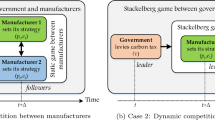Abstract
A three-stage game of production technology, signal and price competition is developed to study the impact of eco-labeling, in a duopoly model of vertical product differentiation. The production technology and the subsequent pollution level are non-observable by consumers. The only way to inform consumers about the environmental quality of the product is to stick an ecolabel on it. However, a polluting firm may also usurp the ecolabel by incurring a certain cost. By assuming that consumers are altruistic and willing to pay for environmental quality, we show that ecolabels can reduce the pollution level. Finally and importantly, under restrictive conditions on labeling cost, ecolabeling can constitute to some extent an environmentally effective and economically efficient policy. However, ecolabeling cannot alone internalize the whole negative externality until the optimum point.
Similar content being viewed by others
References
Akerlof G (1970). The market for ‘lemons’: qualitative uncertainty and the market mechanism. Quart J Econ 84: 488–500
Amacher G, Koskela E and Ollikainen M (2004). Environmental quality competition and eco-labeling. J Environ Econ Manage 47: 284–306
Andreoni J (1990). Impure altruism and donations to public goods: a theory of warm-glow giving?. Econ J 100: 464–477
Auriol E, Schilizzi S (2003) Quality signaling through certification: theory and an application to agricultural seed markets. IDEI Working Paper, Université Toulouse I
Bjørner BT, Garn Hansen L and Russel CS (2003). Environmental labelling and consumers’ choice – an empirical analysis of the effect of the Nordic Swan. J Environ Econ Manage 47: 411–434
Bougherara D, Grolleau G and Thiébaut L (2005). Can labelling policies do more harm than good? An analysis applied to environmental labelling schemes. Eur J Law Econ 19: 5–16
Bourgeon J, Coestier B (1996) Private versus public product labeling. THEMA Working Paper, Université de Paris X, Nanterre
Bruce C and Laroiya A (2007). The production of eco-labels. Environ Res Econ 36: 275–293
Cason TN and Gangadharan L (2002). Environmental labeling and incomplete consumer information in laboratory markets. J Environ Econ Manage 43: 113–134
Coase RH (1960). The problem of social cost. J Law Econ 3: 1–43
Crampes C, Ibanez L (1996) The economics of green labels. GREMAQ Working Paper 96.36.439, Université Toulouse I
Darby MR and Karni E (1973). Free competition and the optimal amount of fraud. J Law Econ 16(1): 67–88
De S and Nabar P (1991). Economic implications of imperfect quality certification. Econ Lett 37: 333–337
Dosi C and Moretto M (2001). Is eco-labelling a reliable environmental policy measure?. Environ Res Econ 18(1): 113–127
Eisenberg N, Miller P (1987) Empathy, sympathy and altruism: empirical and conceptual links. In: Eisenberg N, Strayer J (eds) Empathy and its development, chapter 13. Cambridge University Press, pp 292–316
Environmental Protection Agency (1998). Environmental labeling issues, policies and practices worldwide. Report for the Pollution Prevention Division, US EPA
Foulon J, Lanoie P and Laplante B (2002). Incentives for pollution control: regulation or information?. J Environ Econ Manage 44: 169–187
Gabszewicz J and Thisse J (1979). Price competition, quality and income disparities. J Econ Theory 20: 340–359
Grodsky J (1993). Certified green : the law and future of environmental labeling. Yale J Regul 10: 147–227
Halverson R (1992) Chains, vendors weigh eco-label cos, retailing & the environment. Discount Store News, January, 20
Hamilton SF and Zilberman D (2006). Green markets, eco-certification and equilibrium fraud. J Environ Econ Manage 52: 627–644
Ippolito PM and Matthios AD (1990). The regulation of science-based claims in advertising. J Consumer Policy 13: 413–45
Kirchhoff S (2000). Green business and blue angels: a model of voluntary overcompliance with asymmetric information. Environ Res Econ 15(4): 403–420
Kotchen MJ (2005). Impure public goods and the comparative statics of environmentally friendly consumption. J Environ Econ Manage 49(2): 281–300
Kotchen MJ (2006). Green markets and private provision of public goods. J Political Econ 114(4): 816–834
Leubuscher S, Hager W, Wattiez J, Mombrù JF, Liaska E (1998) Study on verification and control of environmental product claims. Final Report by Prospect C&S for DG Health and Consumer Protection
Linnemer L and Perrot A (2000). Une analyse économique des ‘signes de qualité’: labels et certification des produits. Revue Econ 51(6): 1397–1418
Mason CF (2006). An economic model of eco-labeling. Environ Model Assess 11(2): 131–143
Mattoo A and Singh H (1994). Eco-labelling: policy considerations. Kyklos 47(1): 53–65
Moon W, Florkowski WJ, Brückner B and Schonhof I (2002). Willingness to pay for environmental practices: implications for eco-labeling. Land Econ 78(1): 88–102
Piotrowski R and Kratz S (1999). Eco-labelling in the globalised economy. Int Politics Soc 4: 430–443
Rushton J (1982). Altruism and society: a social learning perspective. Ethics 92(3): 425–446
Teisl M, Roe B and Hicks RL (2002). Can eco-labels tune a market? Evidence from dolphin-safe labeling. J Environ Econ Manage 43: 339–359
Vitalis V (2002) Private voluntary eco-labels: trade distorting, discriminatory and environmentally disappointing. Background paper for the round table on sustainable development, OECD, Paris, 6th December
Wynne RD (1994). The emperor’s new eco-logos? A critical review of the scientific certification system’s environmental report card and the green seal certification mark programs. Virginia Environ Law J 14: 51–149
Author information
Authors and Affiliations
Corresponding author
Rights and permissions
About this article
Cite this article
Ibanez, L., Grolleau, G. Can Ecolabeling Schemes Preserve the Environment?. Environ Resource Econ 40, 233–249 (2008). https://doi.org/10.1007/s10640-007-9150-3
Received:
Accepted:
Published:
Issue Date:
DOI: https://doi.org/10.1007/s10640-007-9150-3




